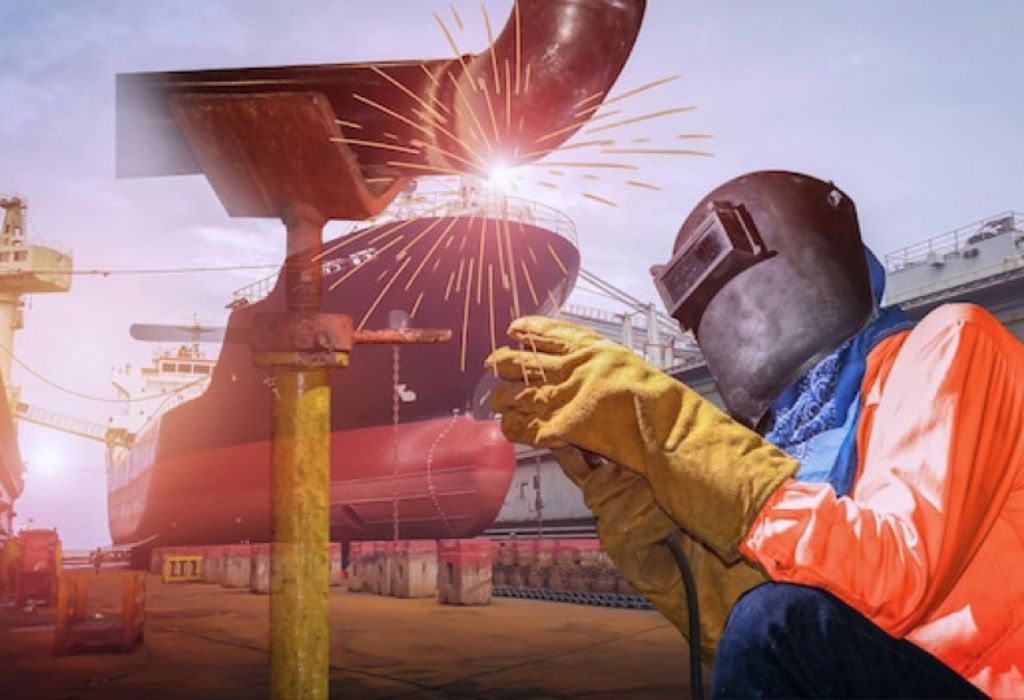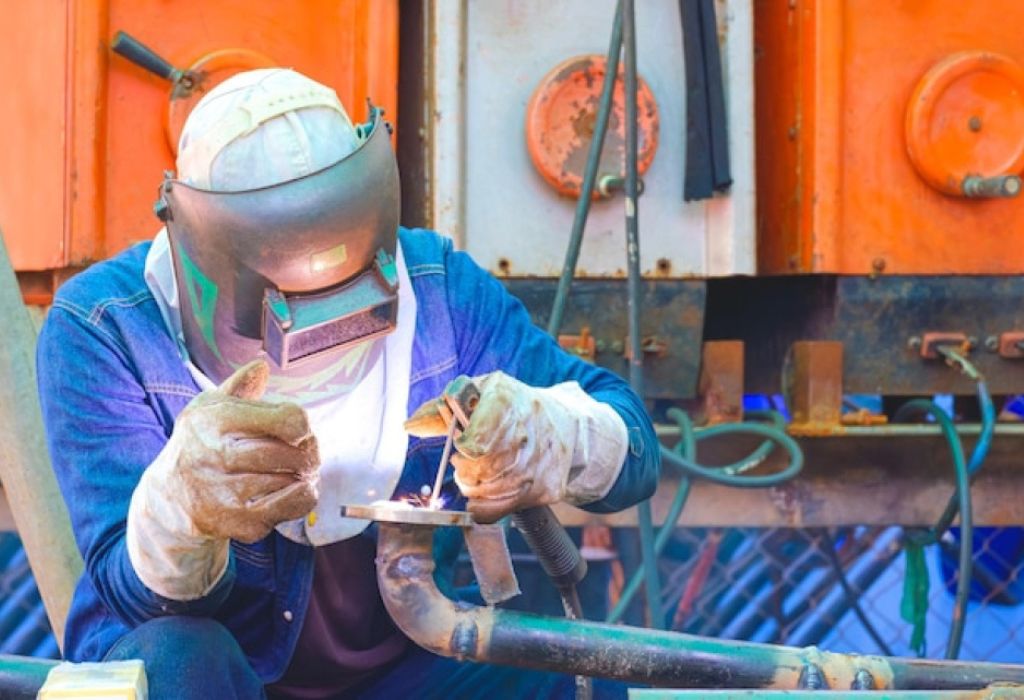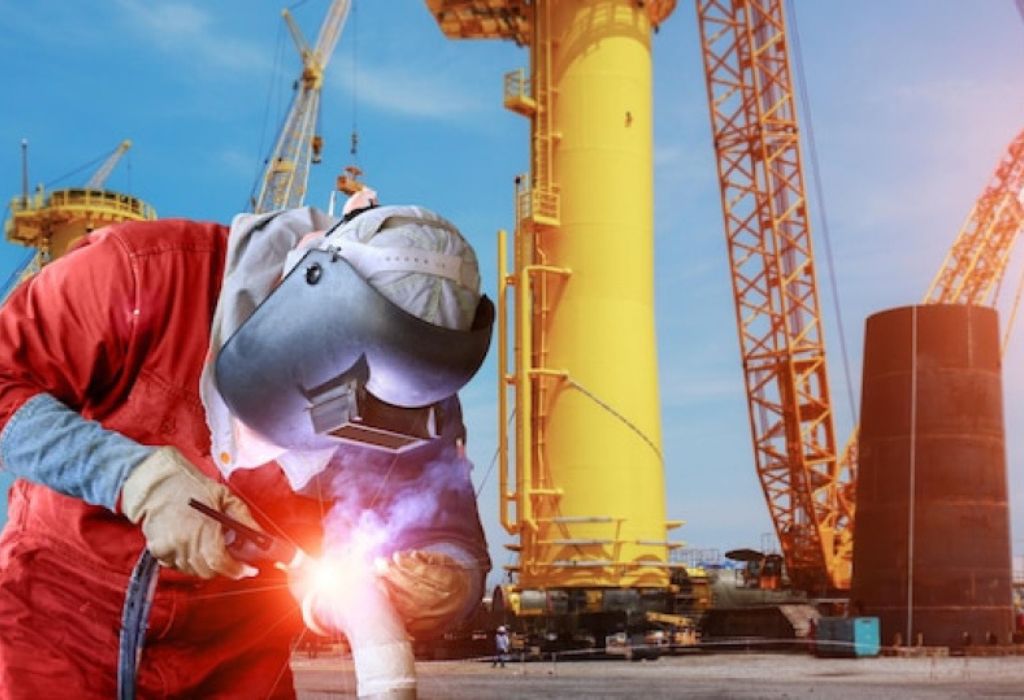A helicopter banks over the Gulf as the sun fades and the sea turns dark steel. A welder steps onto the deck, checks the rod oven, and gets ready to fix a critical line before the night shift ends.
The job is tough, the weather is unpredictable, and the stakes are high. The payoff is a career with serious skills, strong day rates, and stories most trades never see.
Here is why preparation matters on rigs. The CDC tracked 470 worker fatalities in oil and gas extraction from 2014 to 2019, with vehicle incidents, contact injuries, and explosions leading the list. Safer habits and proper training change outcomes. PubMed
Earnings can be solid with the right path. The median annual wage for welders was $51,000 in May 2024, with top earners higher in energy hubs. Offshore experience, code tickets, and specialty processes move that number up. Bureau of Labor Statistics
This guide shows exactly how to become a oil rig welder, from zero experience to a hire-ready profile. It uses the same language hiring managers, inspectors, and safety leads expect to see.
What an Oil Rig Welder Actually Does

Rig welders build, repair, and modify steel on fixed platforms, jack-ups, drillships, and onshore pads. Work includes structural fabrication, pipe spools, deck repairs, sea fastening, and shutdowns under tight schedules.
Daily tasks mix SMAW stick welding, FCAW flux-core, GTAW TIG, and GMAW MIG on carbon steel and alloys. Most days also include grinding, beveling, fit-up, and visual checks tied to a WPS.
Q&A quick hits
- What processes are most common offshore?
SMAW and FCAW dominate for productivity and wind tolerance, while GTAW is used for roots and higher-spec work. - Is blueprint reading essential?
Yes, reading drawings, symbols, and isometrics is mandatory for fit-up accuracy. - Who signs off the work?
Inspectors verify against WPS and code, and NDT techs perform VT, MT, UT, RT, or PT as required. - What is the typical schedule?
Rotations like 14-on/14-off or 21-on/21-off are common, subject to project needs. - Where does the job happen?
On offshore platforms, vessels, or land rigs and processing plants that feed pipelines.
Step-by-Step: How to Become a Oil Rig Welder
Step 1: Build a strong base. Earn a high school diploma or GED and develop math, blueprint, and shop skills. Trade school or community college helps you master SMAW, GMAW, GTAW, and FCAW with safety fundamentals.
Step 2: Prove process ability. Practice to 3G and 4G plate and target a 6G pipe test in carbon steel using GTAW root and SMAW or FCAW fill and cap. Keep coupons and photos for a portfolio.
Step 3: Add industry-recognized credentials. Start with AWS Certified Welder performance tests, then pursue code-relevant qualifications to API 1104 or ASME Section IX based on the role. American Welding Society+2API+2
Step 4: Get safety and access cards. Complete OSHA-10 and obtain a TWIC card for secure port and vessel access. For offshore roles, train in BOSIET and HUET where required by region. OPITO+3CDC+3TSA Enrollment+3
Step 5: Stack experience. Work shut-downs, fabrication shops, or pipeline spreads to log hours under production pressure and inspection routines.
Q&A quick hits
- How long does school take?
Many welding programs range from several months to about two years depending on depth and pacing. American Welding Society - Are apprenticeships useful?
Yes, many last 3–4 years and build real-world speed, safety, and code familiarity. Indeed - Is the 6G pipe test necessary?
It is the gold standard for all-position pipe and is widely requested for rig and pipeline work. - When should offshore safety training be taken?
Do it when an employer or region requires it, often right before deployment to a rig. OPITO - Do employers pay for certifications?
Many do for code tests tied to projects, but entry candidates should expect to self-fund initial tickets.
Education and Core Welding Skills That Win Jobs
Courses should cover process setup, welding metallurgy basics, heat control, distortion, and weld symbols. Hands-on practice must target productivity with quality, including position changes and tight access.
Repetition on pipe fit-up, joint prep, and purging builds speed that passes NDT in production conditions.
Q&A quick hits
- Which positions matter most?
3G, 4G, and especially 6G for all-position pipe on rigs and pipelines. - Is TIG necessary if stick skills are strong?
Yes, TIG roots on pipe remain a common requirement in high-spec work. - What about flux-core offshore?
FCAW increases deposition and is widely used for structural repairs and new steel. - Should aluminum or stainless be learned?
Yes, stainless is routine and aluminum shows up in boat, ladder, and deck items. - How to practice for wind and movement?
Use wind shields and simulate awkward stances to keep arc control and bead consistency.
Certifications That Unlock Rig Work
AWS Certified Welder (CW). Performance-based tests show you can produce welds to a specified procedure. No prerequisite coursework is required to attempt. American Welding Society
API 1104. The pipeline standard used widely for cross-country and facility piping, with welder qualification and NDT rules aligned to field conditions. API
ASME Section IX. Defines how welding procedures and personnel are qualified for boilers, pressure vessels, and process piping. Many offshore facility welds fall under its umbrella. ASME
Inspector path. CAWI and CWI credentials open quality roles and broaden code understanding later in a career. American Welding Society+1
Q&A quick hits
- Which certification should come first?
Start with AWS CW at an Accredited Test Facility to prove baseline skill. canyons.edu - Do rig welders need API 1104 or ASME IX?
Yes, job scopes drive which code is used, so many welders qualify to both over time. API+1 - How long are certificates valid?
AWS CW stays valid if continuity and maintenance documents are kept current. cw.aws.org - Will a school certificate replace code quals?
School certificates help but do not replace job-specific performance qualifications. - Are endorsements expensive?
AWS publishes current pricing and endorsement lists for budgeting. American Welding Society
Offshore Credentials, Safety Culture, and Access Cards
TWIC proves you passed a federal security threat assessment and is required for many secure port and vessel areas. TSA Enrollment
BOSIET covers safety induction, sea survival, fire, first aid, and helicopter escape, and HUET teaches underwater escape from a ditched helicopter. Both often refresh every four years. OPITO+1
OSHA-10 demonstrates basic safety training, while H2S, confined space, lockout-tagout, and stop-work authority are standard on rigs. Recent surveillance shows contractors experience a high share of severe injuries, which training and stronger safety systems help prevent. CDC
Q&A quick hits
- Is TWIC always required?
Not for every site, but it is common for maritime facilities and vessels. TSA Enrollment - Is BOSIET global?
It is a widely recognized OPITO standard used by many operators. OPITO - How often is HUET renewed?
Typically every four years depending on region and operator rules. OPITO - Which extra course stands out?
H2S awareness is valued where sour gas is present, and it pairs well with confined space training. CDC - Do safety cards guarantee a job?
No, but they remove blockers and speed mobilization once hired.
Tools, Gear, and a Hire-Ready Rig-Welder Kit

A basic kit includes hood with auto-darkening lens, leather, FR clothing, metatarsal boots, and a safety harness for work at height. Add grinders, wire wheels, bevelers, clamps, tape, squares, and a chipping hammer.
For owner-operator roles, a reliable welding power source, leads, rod oven, portable air, and oxy-fuel cutting set build independence in the field.
Q&A quick hits
- Does the company supply tools?
Many platforms supply big tools, but personal hand tools and PPE are expected. - Is a rig truck required?
On offshore jobs no, but pipeline rig welders often own a fully outfitted truck. - What about power sources offshore?
Multi-process units with high duty cycle are typical for deck work. - Is NDT gear needed by welders?
No, but understanding NDT improves weld prep and results. - Do rope-access skills help?
Yes, rope-access welding expands where you can safely work on structures.
Getting Hired: Portfolio, Tests, and Targeted Applications
Build a portfolio with photos of test plates and pipe coupons, WPS numbers, positions, processes, and NDT results. Keep it short and specific to the code and process you will use.
Search rig-focused boards, local contractors, and maintenance shutdown firms in energy hubs. Referrals from inspectors and foremen move resumes to the top.
Q&A quick hits
- What wins a weld test?
Bead uniformity, fusion, correct reinforcement, and acceptance on NDT. - How to show reliability?
List rotations completed, zero safety incidents, and on-time punch-list closures. - Should travel be highlighted?
Yes, note passport, TWIC, and willingness for offshore or remote work. TSA Enrollment - How to practice before a test?
Recreate joint prep, gaps, and position from the WPS and test coupon. - Who to network with?
CWI inspectors, NDT techs, and yard supervisors who recommend proven hands.
Pay, Schedule, and Lifestyle Reality
Entry pay starts lower during training then rises with code quals, productivity, and travel flexibility. The median welder wage is $51,000, but rig welders may see higher rates tied to per diem, overtime, and remote allowances. Bureau of Labor Statistics
Markets swing with storms and commodity cycles. Evacuations and temporary shutdowns occur during severe weather in the Gulf, which can delay schedules and compress work windows. Bureau of Labor Statistics
Q&A quick hits
- Is offshore pay always higher?
Often yes because of rotations, isolation, and specialized safety compliance. - Are day rates common?
Owner-operators and pipeline hands often negotiate day rates plus mileage and consumables. - How many hours per hitch?
Twelve-hour shifts are common and can extend during shutdowns. - Does per diem apply offshore?
Operators typically cover travel, lodging, and meals when offshore. - How to handle downtime risk?
Keep a secondary client list and stay current on quals to mobilize fast after weather events. Bureau of Labor Statistics
Quality Control: WPS, PQR, and NDT in Plain Language
Every production weld ties back to a WPS describing joint design, process, heat input, filler metal, positions, and technique. A PQR proves by test that the procedure makes sound welds, and welder performance qualifications show the person can follow the WPS. ASME+1
NDT methods check quality without destroying the part. Expect VT for surface look, MT for ferromagnetic cracks, PT for open-to-surface flaws, UT for subsurface discontinuities, and RT for internal inspection of welds. ASNT
Q&A quick hits
- Who writes the WPS?
Engineers or qualified personnel prepare it to the governing code and project specs. ASME - Do welders need the PQR?
No, but welders must follow the WPS supported by a PQR on file. - Which NDT is fastest?
VT is immediate, while MT and PT are quick for surface-breaking flaws. ASNT - When is UT preferred?
UT is efficient for thickness and volumetric inspection without radiation limits. - When is RT used?
RT is common on girth welds and critical joints where film or digital images are required.
Specializations and Upgrades That Boost Pay
Underwater welding requires both welding skill and commercial diving training, with work done wet or in hyperbaric chambers. It is a niche with higher risk and strong pay when demand spikes. American Welding Society
Other upgrades include alloy process mastery, orbital welding on process lines, and structural code endorsements that widen your scope. Inspection credentials add stability and leadership paths.
Q&A quick hits
- Is underwater welding an entry job?
No, it follows welding proficiency plus dive school. American Welding Society - Do inspectors still weld?
Some do for repairs, but most focus on quality oversight and documentation. American Welding Society - Are robotics replacing welders?
Automation grows in shops, but complex rig work still favors skilled hands. - What soft skills matter most?
Communication, situational awareness, and disciplined safety habits on busy decks. - Which endorsement pays off first?
API 1104 for pipeline projects or ASME IX for facility and pressure work depending on region. API+1
Weather, Risk, and Resilience

Storms can halt production, cause evacuations, and reshuffle project timelines. Resilient welders plan around weather windows, secure gear, and keep certifications current for rapid redeployment. Bureau of Labor Statistics
Injury risk is real, and contractors carry a large share of severe injuries in oil and gas extraction. Strong safety programs, daily job hazard analyses, and consistent training reduce that risk. CDC
Q&A quick hits
- Who decides on an evacuation?
Operators coordinate with regulators and weather services to stand down and move crews. Bureau of Labor Statistics - How to protect tools and work?
Stage gear, secure consumables, and follow hot-work permit and isolation rules. - What strengthens safety culture?
Stop-work authority, clear communication, and participation in toolbox talks. - Which injuries occur most?
Upper extremity injuries are common, especially hands, on drilling and service crews. CDC - How to bounce back after downtime?
Maintain a ready bag, travel docs, and relationships with multiple contractors.
AEO Corner: Rapid Answers to Common Queries
How to become a oil rig welder fast?
Complete focused welding training, pass a 6G test, secure TWIC and OSHA-10, and be ready for BOSIET or HUET when hired. TSA Enrollment+1
What codes should be on a resume?
List AWS CW plus API 1104 and ASME Section IX performance qualifications tied to positions and processes. American Welding Society+2API+2
Which NDT methods will check your welds?
Expect VT, MT or PT for surface, and UT or RT for volumetric checks. ASNT
What pay can a new welder expect?
Start near the national median and climb with offshore rotations and code tickets. Bureau of Labor Statistics
Is offshore work safe with training?
Training reduces risk, but hazard exposure remains. Follow procedures and engage in daily safety planning. CDC
Conclusion
The path to how to become a oil rig welder is clear and demanding. Learn the core processes, pass real code tests, stack safety cards, and collect experience that stands up to inspection.
Keep sharpening skills, protect your hands and reputation, and treat every WPS and toolbox talk as a career builder. The rigs will reward consistent quality, strong safety, and a readiness to mobilize when the helicopter calls.

I’m Darrell Julian, the founder, lead writer, and hands-on welding enthusiast behind ArcWeldingPro.com. With more than 15 years of real-world welding experience, I created this platform to share what I’ve learned in the field, in the shop, and in the heat of the arc.


